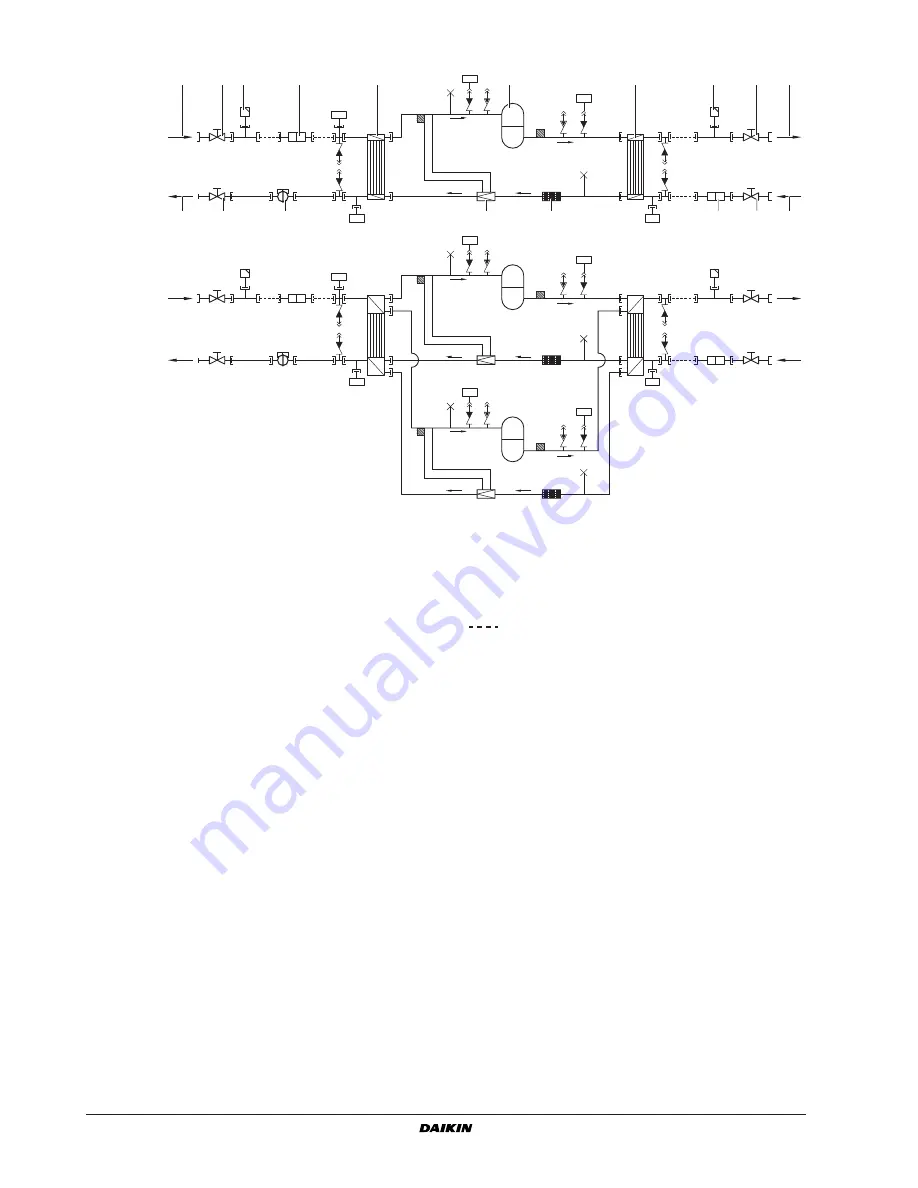
Operation manual
3
EWWP014~065KBW1N
Packaged water-cooled water chillers
4PW61660-1A – 04.2012
Function of the main components
Figure -
Functional diagram
As the refrigerant circulates through the unit, changes in its state or
condition occur. These changes are caused by the following main
components:
■
Compressor
The compressor (M*C) acts as a pump and circulates the
refrigerant in the refrigeration circuit. It compresses the
refrigerant vapour coming from the evaporator to a pressure at
which it can easily be liquefied in the condenser.
■
Condenser
The function of the condenser is to change the state of the
refrigerant from gaseous to liquid. The heat gained by the gas in
the evaporator is discharged through the condenser and the
vapour condenses to liquid.
■
Filter
The filter installed behind the condenser removes small particles
from the refrigerant to prevent blockage of the tubes.
■
Expansion valve
The liquid refrigerant coming from the condenser enters the
evaporator via an expansion valve. The expansion valve brings
the liquid refrigerant to a pressure at which it can easily be
evaporated in the evaporator.
■
Evaporator
The main function of the evaporator is to take heat from the
water that flows through it. This is done by turning the liquid
refrigerant, coming from the condenser, into gaseous refrigerant.
■
Water in/outlet connections
The water inlet and outlet connection allow an easy connection
of the unit to the water circuit of the air handling unit or industrial
equipment.
Safety devices
The unit is equipped with
General safety devices
: shut down all
circuits and stop the whole unit.
■
I/O PCB (A2P) (input/output)
The I/O PCB (A2P) contains a reverse phase protector.
The reverse phase protector detects if the 3 phases of the power
supply are connected correctly. If a phase is not connected or if
2 phases are inverted, the unit can not start up.
■
Overcurrent relay
The overcurrent relay (K*S) is located in the switch box of the
unit and protects the compressor motor in case of overload,
phase failure or too low voltage. The relay is factory-set and may
not be adjusted. When activated, the overcurrent relay has to be
reset in the switch box and the controller needs to be reset
manually.
■
High-pressure switch
The high-pressure switch (S*HP) is installed on the discharge
pipe of the unit and measures the condenser pressure (pressure
at the outlet of the compressor). When the pressure is too high,
the pressure switch is activated and the circuit stops.
When activated, it resets automatically, but the controller needs
to be reset manually.
■
Low pressure switch
The low-pressure switch (S*LP) is installed on the suction pipe
of the unit and measures the evaporator pressure (pressure at
the intlet of the compressor). When the pressure is too low, the
pressure switch is activated and the circuit stops.
When activated, it resets automatically, but the controller needs
to be reset manually.
S4LP
S1HP
R3T
R5T
Q1D
HP
LP
M1C
R4T
1
2
7
6
5
3
11
9
9
10
6
7
4
S5LP
S2HP
Q2D
HP
LP
M2C
8
R3T
R4T
9
9
10
11
R5T
S4LP
S1HP
Q1D
HP
LP
M1C
EWWP012~035KB
EWWP045~065KB
1
Compressor
7
Water outlet
2
Condenser
8
Flow switch (delivered with the unit, installed in the field)
3
Filter
9
Ball valve (delivered with the unit, installed in the field)
4
Expansion valve
10
Water filter (delivered with the unit, installed in the field)
5
Evaporator
11
Air purge valve (delivered with the unit, installed in the field)
6
Water inlet
Field piping





































